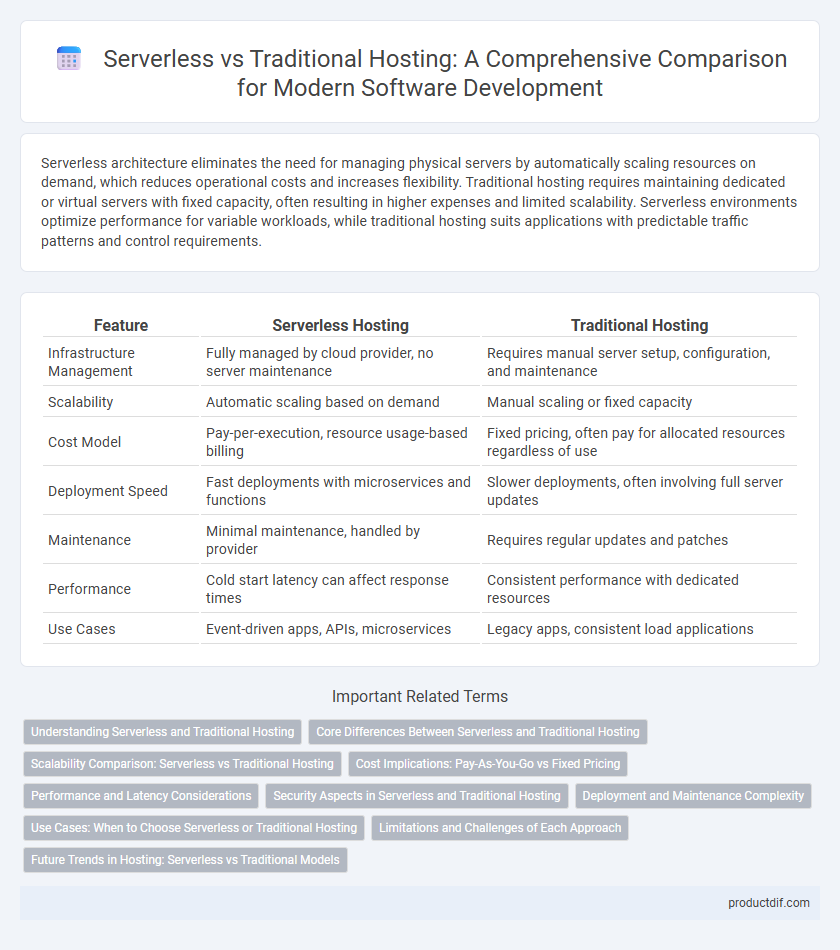Serverless architecture eliminates the need for managing physical servers by automatically scaling resources on demand, which reduces operational costs and increases flexibility. Traditional hosting requires maintaining dedicated or virtual servers with fixed capacity, often resulting in higher expenses and limited scalability. Serverless environments optimize performance for variable workloads, while traditional hosting suits applications with predictable traffic patterns and control requirements.
Table of Comparison
| Feature | Serverless Hosting | Traditional Hosting |
|---|---|---|
| Infrastructure Management | Fully managed by cloud provider, no server maintenance | Requires manual server setup, configuration, and maintenance |
| Scalability | Automatic scaling based on demand | Manual scaling or fixed capacity |
| Cost Model | Pay-per-execution, resource usage-based billing | Fixed pricing, often pay for allocated resources regardless of use |
| Deployment Speed | Fast deployments with microservices and functions | Slower deployments, often involving full server updates |
| Maintenance | Minimal maintenance, handled by provider | Requires regular updates and patches |
| Performance | Cold start latency can affect response times | Consistent performance with dedicated resources |
| Use Cases | Event-driven apps, APIs, microservices | Legacy apps, consistent load applications |
Understanding Serverless and Traditional Hosting
Serverless hosting eliminates the need for server management by automatically scaling resources and charging only for actual usage, offering increased flexibility and cost efficiency. Traditional hosting requires dedicated server management and fixed resource allocation, often resulting in higher operational overhead and less scalability. Understanding the distinctions in infrastructure control, scalability, and cost models is essential for selecting the appropriate hosting solution based on application requirements and business goals.
Core Differences Between Serverless and Traditional Hosting
Serverless hosting eliminates the need for server management by automatically scaling resources based on demand, whereas traditional hosting relies on fixed server infrastructure requiring manual configuration and maintenance. Serverless architectures charge based on actual usage with event-driven execution, contrasting with traditional hosting's upfront provisioning and consistent cost regardless of workload. Performance optimization in serverless environments is dynamic, adapting to traffic fluctuations, while traditional hosting demands proactive capacity planning to prevent under or over-provisioning.
Scalability Comparison: Serverless vs Traditional Hosting
Serverless architecture offers automatic scalability by dynamically allocating resources based on real-time demand, eliminating the need for manual intervention or over-provisioning. Traditional hosting requires pre-configured server capacity, often leading to inefficient resource usage during traffic spikes or lulls. Serverless platforms provide event-driven scaling with granular billing, making them more cost-effective and responsive compared to fixed-capacity traditional servers.
Cost Implications: Pay-As-You-Go vs Fixed Pricing
Serverless hosting offers a pay-as-you-go pricing model, charging based on actual resource consumption which reduces upfront costs and accommodates fluctuating workloads efficiently. Traditional hosting typically involves fixed pricing, requiring payment for allocated server resources regardless of usage, leading to potentially higher costs during periods of low demand. Businesses with variable traffic patterns benefit financially from serverless architectures, while consistent, predictable workloads may find traditional hosting more cost-effective.
Performance and Latency Considerations
Serverless architecture offers dynamic resource allocation that can significantly reduce latency by scaling automatically based on incoming traffic, optimizing response times for varying workloads. Traditional hosting may suffer from performance bottlenecks during traffic spikes due to fixed resource allocation, resulting in higher latency under heavy load conditions. Evaluating the specific application demands and traffic patterns is crucial when choosing between serverless and traditional hosting to ensure optimal performance and minimal latency.
Security Aspects in Serverless and Traditional Hosting
Serverless architectures inherently reduce attack surfaces by abstracting server management and automatically applying security patches, minimizing risks associated with outdated infrastructure. Traditional hosting demands continuous manual security oversight, including patch management, firewall configurations, and intrusion detection, which can expose vulnerabilities if not diligently maintained. While serverless platforms offer built-in isolation and managed security, their reliance on third-party providers introduces concerns about data control and compliance that must be carefully addressed.
Deployment and Maintenance Complexity
Serverless hosting eliminates the need for manual server management, allowing automatic scaling and simplified deployment through cloud provider services like AWS Lambda or Azure Functions. Traditional hosting requires configuring and maintaining physical or virtual servers, leading to increased complexity in deployment, updates, and infrastructure management. Serverless architectures reduce maintenance overhead by abstracting server infrastructure, enabling developers to focus on code rather than server operations.
Use Cases: When to Choose Serverless or Traditional Hosting
Serverless hosting excels in applications with variable workloads, such as real-time data processing, event-driven APIs, and microservices, due to its automatic scaling and cost efficiency. Traditional hosting remains ideal for legacy applications, long-running processes, and workloads requiring full control over server environments or consistent high performance. Evaluating factors like traffic predictability, customization needs, and operational overhead guides the decision between serverless and traditional hosting models.
Limitations and Challenges of Each Approach
Serverless hosting faces limitations such as cold start latency, limited execution duration, and difficulties in debugging and monitoring due to abstraction layers. Traditional hosting challenges include higher maintenance costs, manual scaling complexities, and resource inefficiencies from over-provisioning or under-utilization. Both approaches require careful consideration of workload patterns, performance requirements, and operational expertise to optimize deployment strategies.
Future Trends in Hosting: Serverless vs Traditional Models
Serverless architectures are projected to dominate future hosting trends due to their scalability, cost efficiency, and reduced operational overhead compared to traditional hosting models, which rely heavily on fixed infrastructure and manual resource management. Advances in edge computing and AI-driven automation further enhance serverless platforms, enabling faster deployment and real-time responsiveness across distributed environments. Traditional hosting remains relevant for legacy systems and applications requiring persistent server control, but market analysis predicts a significant shift toward event-driven and containerized serverless solutions by 2026.
Serverless vs Traditional Hosting Infographic

 productdif.com
productdif.com